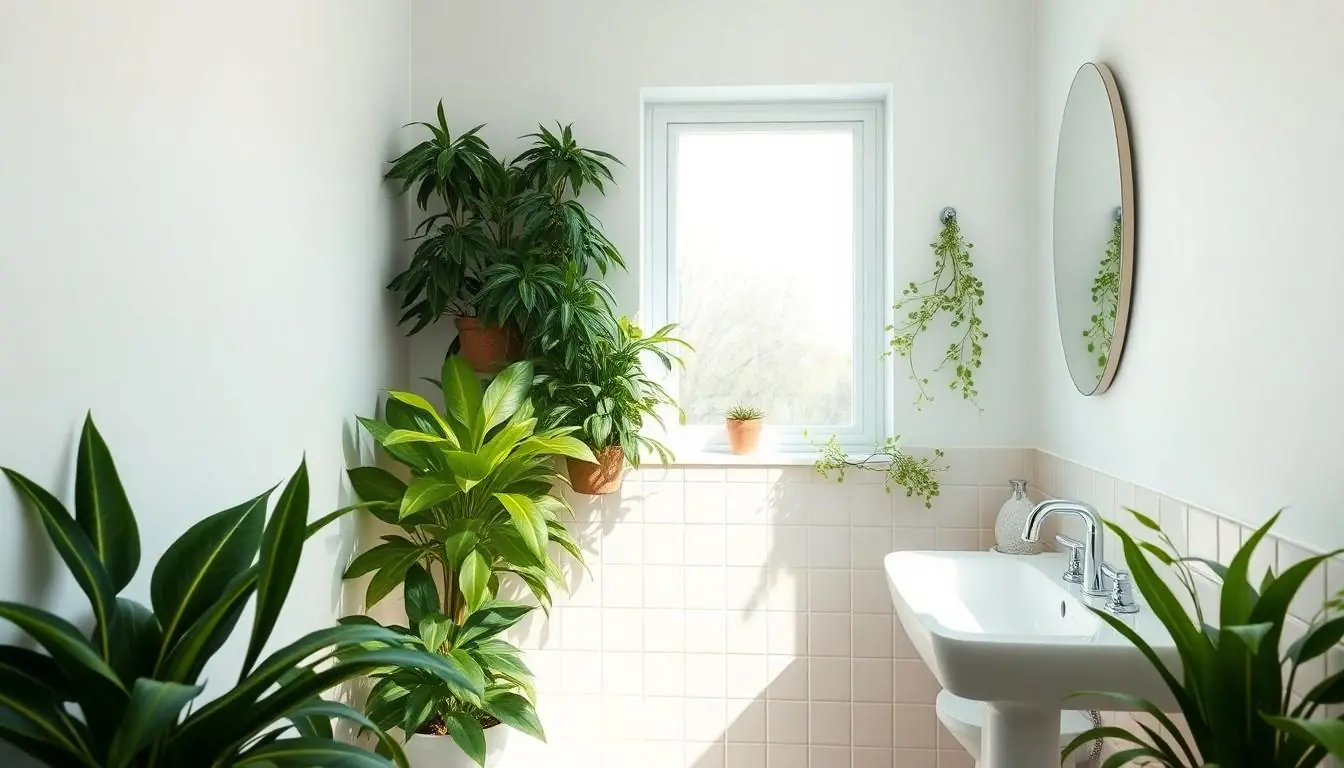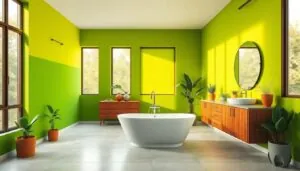When it comes to small bathrooms, choosing the right color can feel like trying to find a needle in a haystack—if that needle was also a perfect shade of mint green. The right hues can transform a cramped space into a cozy retreat, making those morning routines a little less like a circus act. Forget the drab whites and beiges that scream “blah.” It’s time to embrace colors that not only open up the space but also reflect personality.
Imagine stepping into a bathroom that feels airy and inviting, where every splash of color makes you smile. From soft pastels to bold statements, the right palette can create an illusion of space and style. Let’s dive into the world of bathroom colors that’ll make even the tiniest of spaces feel like a luxurious spa—without the hefty price tag or the awkward small talk with the receptionist.
Table of Contents
TogglePopular Bathroom Colors For Small Bathrooms
Choosing the right colors can significantly impact the feel of a small bathroom. Several popular colors enhance space and style.
Light Colors
Light colors create an airy ambiance in small bathrooms. Soft tones like pale blue and mint green reflect light, making spaces feel larger. Shades of light gray provide a modern touch while maintaining brightness. Utilizing light colors on walls and ceilings also enhances a sense of openness. Accessories in complimentary pastel tones can further augment this effect.
Neutral Colors
Neutral colors offer timeless appeal, making them popular for small bathrooms. Shades like beige, taupe, and soft whites serve as versatile backdrops. These hues blend easily with various decor styles, allowing for personal expression. Mixing different neutral tones can create depth instead of monotony. Adding texture through materials like wood or stone can enhance the overall aesthetic while remaining soothing.
Bold Colors
Bold colors make a striking impression in small bathrooms while maximizing style. Deep navy, forest green, and rich burgundy instill sophistication and warmth. When used as accent walls or through vibrant tiles, these hues create focal points. Adding white fixtures alongside bold colors balances visual weight. Using bold accents judiciously allows for individual expression without overwhelming the space.
Tips For Choosing The Right Color

Choosing the right color for a small bathroom involves careful consideration of various factors. Here are key tips to guide the decision-making process.
Consider Lighting
Natural light influences how colors appear in a space. Well-lit bathrooms often benefit from lighter hues, which reflect sunlight and enhance brightness. In contrast, darker bathrooms might require brighter shades to prevent a gloomy atmosphere. Additionally, artificial lighting can affect color perception, making it vital to test paint samples under different light sources. Assessing the bathroom’s orientation can provide insight into how much natural light it receives daily.
Use of Color Psychology
Colors evoke specific emotions and perceptions, impacting how a space feels. Soft pastels instill calmness, creating a serene sanctuary ideal for relaxation. Bold colors can energize and invigorate, making them suitable for a vibrant environment. Neutral tones offer a sense of balance, allowing for versatile décor options while maintaining an inviting atmosphere. Understanding color psychology helps tailor the bathroom’s mood to suit personal preferences and enhance the overall experience.
Accent Colors To Enhance Small Bathrooms
Accent colors play a crucial role in transforming small bathrooms, adding depth and personality. Incorporating contrasting hues can create interest and highlight architectural features or fixtures.
Adding Contrast
Choosing contrasting colors amplifies the impact of the existing palette. Dark shades paired with light tones effectively define space and create visual interest. For instance, a deep navy accent wall against soft gray tiles offers a striking balance. Another option includes mixing a vibrant hue with neutral elements, such as a rich emerald green vanity against white cabinetry. These combinations enhance the overall aesthetic and draw attention to selected areas without overwhelming the space.
Accessories and Decor
Accessories serve as perfect tools for introducing accent colors. Colorful rugs, towels, and shower curtains can infuse vibrancy while remaining easy to change. Bright accessories such as a citrus yellow soap dispenser or a cobalt blue bathroom mat can effortlessly revitalize the entire room. Wall art featuring bold shades adds personality and can even complement other elements. Lighting fixtures with colored shades further enhance the ambiance, contributing to a well-rounded design. By carefully selecting these decor items, individuals can achieve a cohesive look that feels custom to their unique style.
Common Mistakes To Avoid
Color choices can dramatically influence small bathrooms. Avoiding certain missteps ensures a more inviting and cohesive design.
Dark Colors Overwhelm
Opting for dark colors in small bathrooms often leads to a cramped feeling. Darkness absorbs light, making spaces look smaller and less welcoming. Shades like deep navy or charcoal can be striking when used minimally. They function best as accents rather than the primary color. Use dark tones sparingly on one wall or select small decor items to enhance depth without overshadowing the room. In contrast, pairing dark colors with lighter elements creates balance, preventing overwhelming effects while adding sophisticated flair.
Ignoring Space and Scale
Neglecting space and scale when choosing colors can disrupt a bathroom’s flow. Color selection should consider the actual size of surfaces, such as walls and fixtures. Small-scale patterns or overly bold colors can dominate limited space, leading to an uncoordinated look. Ensuring that colors harmonize with bathroom dimensions promotes unity and visual comfort. Additionally, selecting paint finishes carefully affects the perception of space. Glossy finishes reflect light, creating a more open atmosphere, while matte may absorb it, exacerbating tightness. Prioritizing appropriate colors and finishes enhances the overall design and functionality of small bathrooms.
Choosing the right colors for small bathrooms can make a significant difference in both aesthetics and functionality. By opting for light and airy shades or thoughtfully placed bold accents, homeowners can create an inviting atmosphere that feels spacious and stylish. It’s essential to consider how natural light interacts with colors and to test samples in various lighting conditions.
Incorporating accent colors through decor and accessories allows for personal expression while maintaining balance. With careful selection and a focus on color psychology, small bathrooms can transform into serene retreats or vibrant spaces that reflect individual style and enhance daily experiences.


